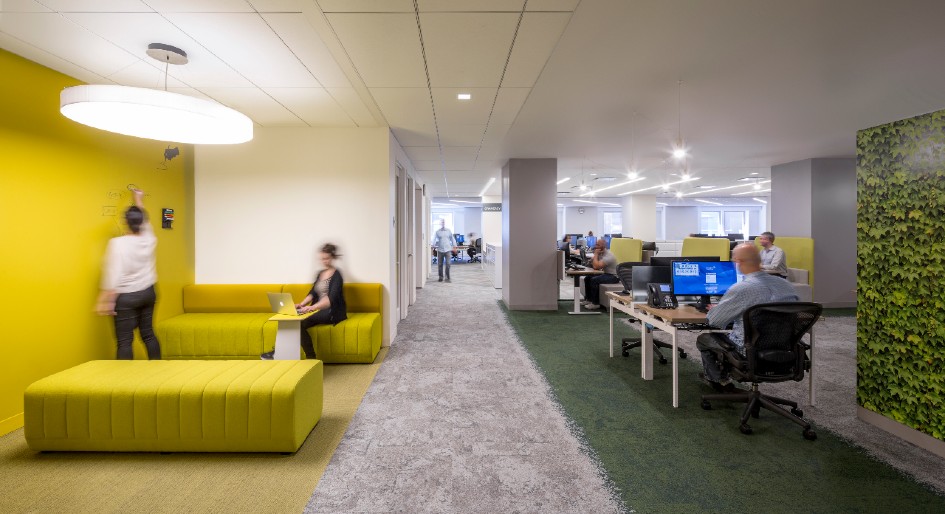As we reflect on more than a year of unprecedented global stressors and contemplate a return to the workplace, the necessity of creating a comforting environment for employees cannot be understated. With so many workers facing difficult decisions about returning to enclosed office spaces, it is the responsibility of designers to make the transition as easy as possible and above all, to ensure that occupants feel safe. Something often overlooked is the simple power of colour to promote a sense of comfort and ease in the workplace, and to enable us to treat our fellow humans with greater empathy and kindness.
It’s all about the first impression; if employees feel welcomed as they enter a space, they are more likely to maintain a sense of safety and be productive throughout their work day. During a global crisis fueled in part by psychological fear, the feeling of being cared for by our fellow humans goes a long way in boosting comfort levels. For city-dwellers whose daily commute requires travel through areas of heightened activity, or for workers seeking relief from media over-saturation and cramped living environments, the workspace can function as a retreat from the overstimulation of daily life.
To offer inspiration and direction for workplace designers, global paint suppliers are reflecting these trends in recently released colours palettes. For instance, PPG Paints just released “Be Well,” which includes: Transcend, a mid-tone oatmeal-coloured hue that draws on earthy influences; Misty Aqua, a watercolour cerulean blue; and Big Cypress, a shaded ginger with persimmon undertones. This selection of earthy, tranquil colours evokes natural elements and brings to mind the restorative interiors of a spa. At a time when people are searching for safe havens, the overlap between the objectives of a spa and an office is greater than one might think. Incorporating colour palettes that conjure memories of peaceful outdoor environments is an effective way to reduce stress levels. In complement to the representative quality of earthy paint tones, integrating natural elements into the workplace adds further texture and depth.
The premise of biophilic design is that humans fundamentally seek to make connections with the natural world, which in turn increases interpersonal connections. As urbanization drives us further from the outside world, the desire for access to green spaces and fresh air has skyrocketed. Bringing the outdoors in is critical in the creation of healthy work environments. The integration of plants, sunlight, and water elements not only enhances the colour and look of a space but has been shown through scientific studies to increase physical and mental well-being, reduce blood pressure and heart rates, and even support cognitive function and creativity.
Access to natural light is key. Paint colours and natural elements look their best when illuminated by rays of sunlight. Beyond aesthetics, the benefits of exposure to Vitamin D are vast, from heightened productivity to overall mood regulation. Workplace designers can incorporate large windows that take advantage of available views, install skylights wherever possible, and consider adding balcony spaces or courtyards. Allowing occupants control of window settings encourages air filtration in enclosed spaces, which also decreases the spread of germs.
Historically, biophilic design is one of the first aspects to be value-engineered out of a design, as project managers make tough decisions about cost-effectiveness and which aspects of a plan are “necessary.” This is the key shift in priorities that we will see in the years following the COVID-19 crisis. Employers can no longer afford to overlook the emotional health of their workers, and will be more inclined to invest in these kinds of human-centred approaches to interior design. If we are able to walk away from this difficult time with a greater regard for our fellow humans, it will be a silver lining in the midst of great hardship.
Rachel Robinson, IIDA, LEED AP, is the design director at Ted Moudis Associates. She is a collaborative leader who guides and inspires design teams through all project phases, from programming through implementation. Her thoughtful, analytical approach to design has led to a timeless body of work that spans national and global work for large-scale corporate, hospitality, government, institutional, and higher education projects.








